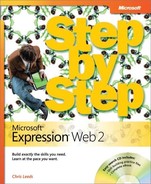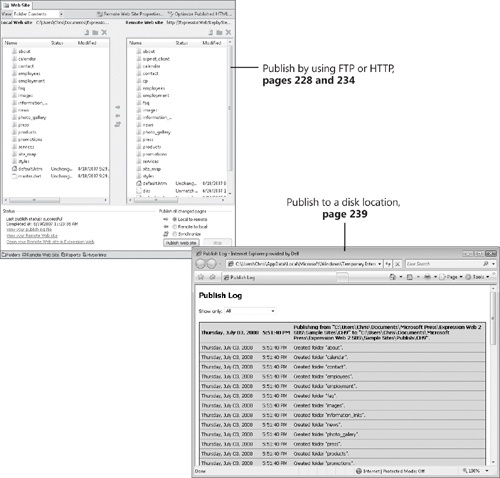✓ | |
✓ | |
✓ | |
✓ | |
✓ | |
✓ | |
After you’ve taken all the time and trouble to create a Web site and get everything set up the way you want, you are probably going to want people to be able to access it. Whether it’s a site for only a select group of users (an intranet site), or a site for the general public (an Internet site), you will need the files and folders in your local site to reside on a server.
From a Microsoft Expression Web 2 standpoint, moving the local files and folders that comprise your site to a server is where publishing comes in. Although publishing might, on its surface, seem like simply copying files from your local site to a server, there’s actually a lot more going on during this operation. In addition to the publishing operation copying the files and folders from one place to another, Expression Web 2 keeps tabs on what’s been published, where it’s been published to, and when each file was last published. Add to that the fact that, with Expression Web 2, you can publish not only from your local site to a server but also from a server back down to your local computer, or even from one server to another server without copying the files to your local computer at all, and the complexity and usefulness of the publishing functions of Expression Web 2 become quite apparent.
From within Expression Web 2, you have four choices for publishing:
Microsoft Office FrontPage Server Extensions publishing
Requires FrontPage Server Extensions on the server. Check with your host to see if they are available.
Provides for encrypted transfer of user name and passwords by using the HTTP protocol to publish.
Allows for maximum exploitation of the Expression Web 2 features and greater security than File Transfer Protocol (FTP) publishing.
WebDAV publishing
Requires Distributed Authoring and Versioning (DAV) to be set up on the server. Check with your host to see if this is an option for your site.
Is currently fairly rare but provides a feature set that is otherwise not available.
See Also
For more information about WebDAV, visit www.webdav.org.
FTP publishing
Requires FTP to be set up on the server. Check with your host for FTP parameters for your site.
Is the most common and widely available form of publishing.
File System publishing
Publishes a disk-based site from one folder structure to another.
Is generally used to "copy" a site from one location on your computer to another for administrative purposes.
Has no requirements, but also results in minimal capabilities at the publish location.
In this chapter, you will be introduced to the various types of publishing and to the publishing prerequisites, such as securing a domain name and hosting for your site.
Important
Before you can use the practice files in this chapter, you need to install them from the book’s companion CD to their default location. For more information about practice files, see "Features and Conventions of This Book" at the beginning of this book.
Troubleshooting
Graphics and operating system–related instructions in this book reflect the Windows Vista user interface. If your computer is running Windows XP and you experience trouble following the instructions as written, please refer to the "Introducing Expression Web 2" section at the beginning of this book.
To improve the readability of the graphics in this book, Expression Web 2 was set to use the Windows color scheme instead of the default Expression Studio 2 color scheme.
There are many server types on which you can host your domain and site. For the purposes of this discussion, we will divide them into two main categories: those that run a Windows operating system, and those that do not.
The decision about which server type to use depends solely on what kind of files and functionality you either have currently in your site or plan to include in the future. Use these guidelines:
If your site has or will have Microsoft dynamic pages such as ASP.NET, or ASP files, or if the site requires a Microsoft Office Access or Microsoft SQL Server database, you should choose a Windows server with the appropriate Microsoft .NET Framework version and the appropriate database capabilities.
If your site has or will have non-Windows dynamic pages such as PHP or a MySQL server, then you could use a non-Windows server, although PHP and MySQL run fine on a Windows server if the server administrator configures and allows it.
If your site has only static pages (.htm/.html) and you don’t intend to add server-side functionality, it really doesn’t matter which server type you choose.
When choosing a server to host your site, it’s important to make a good initial decision. It can be a tremendous hassle to move a site after it’s been deployed to a server. The decision is complicated by the fact that there are literally tens of thousands of hosts you can choose from. A little due diligence is definitely required on this topic. A good place to start, by using the experience of others, is at www.webhostingtalk.com.
Some of the things you’ll need after signing up for hosting space include:
A user name and password for publishing. Whether you opt for HTTP, FTP, or WebDAV, you will be issued a unique user name and password.
The URL or folder you are supposed to publish into. Some hosts have a specific folder in your Web space that you must publish into.
The DNS settings your host requires you to use. To enable visitors to arrive at your site on your hosting space, you will need to use the appropriate DNS settings. These settings are changed within the account where you registered your domain name. At least two DNS entries are required—for example, NS1.EXAMPLE.COM and NS2.EXAMPLE.COM. When you change these settings at your registrar, it can take up to 72 hours for the settings to propagate throughout the Internet.
After you set up your hosting space, you’ll be ready to move on to publishing your files and folders to the Internet. Resist the urge to find the cheapest host, or to make a quick decision. This is one of those points where taking some additional time in the beginning can save you much more time and trouble in the future.

